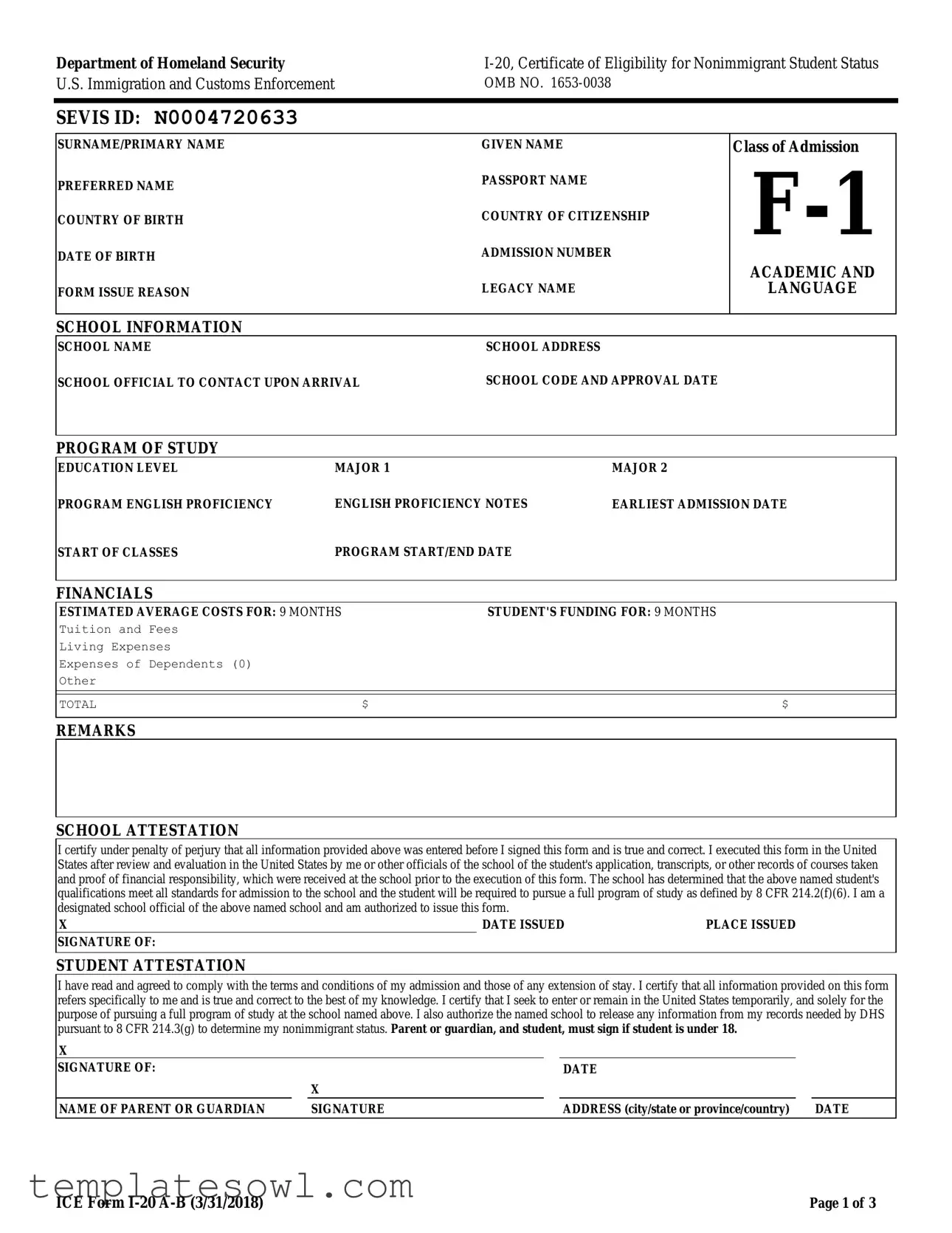INSTRUCTIONS TO STUDENTS
STUDENT ATTESTATION. You should read everything on this page carefully. Be sure that you understand the terms and conditions concerning your admission and stay in the United States as a nonimmigrant student before signing the student attestation on page 1 of the Form I-20 A-B. The law provides severe penalties for knowingly and willfully falsifying or concealing a material fact, or using any false document in the submission of this form.
FORM I-20. The Form I-20 (this form) is the primary document to show that you have been admitted to school in the United States and that you are authorized to apply for admission to the United States in F-1 class of admission. You must have your Form I-20 with you at all times. If you lose your Form I-20, you must request a new one from your designated school official (DSO) at the school named on your Form I-20.
VISA APPLICATION. You must give this Form I-20 to the U.S. consular officer at the time you apply for a visa (unless you are exempt from visa requirements). If you have a Form I-20 from more than one school, be sure to present the Form I-20 for the school you plan to attend. Your visa will include the name of that school, and you must attend that school upon entering the United States. You must also provide evidence of support for tuition and fees and living expenses while you are in the United States.
ADMISSION. When you enter the United States, you must present the following documents to the officer at the port of entry: 1) a Form I-20; 2) a valid F-1 visa(unless you are exempt from visa requirements); 3) a valid passport; and
4)evidence of support for tuition and fees and living expenses while you are in the United States. The agent should return all documents to you before you leave the inspection area.
REPORT TO SCHOOL NAMED ON YOUR FORM I-20 AND VISA. Upon your first entry to the United States, you must report to the DSO at the school named on your Form I-20 and your F-1 visa (unless you are exempt from visa requirements). If you decide to attend another school before you enter the United States, you must present a Form I-20 from the new school to a U.S. consular officer for a new F-1 visa that names the new school. Failure to enroll in the school, by the program start date on your Form I-20 may result in the loss of your student status and subject you to deportation.
EMPLOYMENT. Unlawful employment in the United States is a reason for terminating your F-1 status and deporting you from the United States. You may be employed on campus at your school. You may be employed off-campus in curricular practical training (CPT) if you have written permission from your DSO. You may apply to U.S. Citizenship and Immigration Services (USCIS) for off-campus employment authorization in three circumstances: 1) employment with an international organization; 2) severe and unexpected economic hardship; and 3) optional practical training (OPT) related to your degree. You must have written authorization from USCIS before you begin work. Contact your DSO for details. Your spouse or child (F-2 classification) may not work in the United States
PERIOD OF STAY. You may remain in the United States while taking a full course of study or during authorized employment after your program. F-1 status ends and you are required to leave the United States on the earliest of the following dates: 1) the program end date on your Form I-20 plus 60 days; 2) the end date of your OPT plus 60 days; or 3) the termination of your program for any other reason. Contact your DSO for details.
EXTENSION OF PROGRAM. If you cannot complete the education program by the program end date on page 1 of your Form I-20, you should contact your DSO at least 15 days before the program end date to request an extension.
SCHOOL TRANSFER. To transfer schools, first notify the DSO at the school you are attending of your plan to transfer, then obtain a Form I-20 from the DSO at the school you plan to attend. Return the Form I-20 for the new school to the DSO at that school within 15 days after beginning attendance at the new school. The DSO will then report the transfer to the Department of Homeland Security (DHS). You must enroll in the new school at the next session start date. The DSO at the new school must update your registration in SEVIS.
NOTICE OF ADDRESS. When you arrive in the United States, you must report your U.S. address to your DSO. If you move, you must notify your DSO of your new address within 10 days of the change of address. The DSO will update SEVIS with your new address.
REENTRY. F-1 students may leave the United States and return within a period of five months.To return, you must have: 1) a valid passport; 2) a valid F- 1 student visa (unless you are exempt from visa requirements); and 3) your Form I-20, page 2, properly endorsed for reentry by your DSO. If you have been out of the United States for more than five months, contact your DSO
AUTHORIZATION TO RELEASE INFORMATION BY SCHOOL. DHS requires your school to provide DHS with your name, country of birth, current address, immigration status, and certain other information on a regular basis or upon request. Your signature on the Form I-20 authorizes the named school to release such information from your records.
PENALTY. To maintain your nonimmigrant student status, you must: 1) remain a full-time student at your authorized school; 2) engage only in authorized employment; and 3) keep your passport valid. Failure to comply with these regulations will result in the loss of your student status and subject you to deportation.
INSTRUCTIONS TO SCHOOLS
Failure to comply with 8 CFR 214.3(k) and 8 CFR 214.4 when issuing Forms I- 20 will subject you and your school to criminal prosecution. If you issue this form improperly, provide false information, or fail to submit required reports, DHS may withdraw its certification of your school for attendance by nonimmigrant students.
ISSUANCE OF FORM I-20. DSOs may issue a Form I-20 for any nonimmigrant your school has accepted for a full course of study if that person:
1)plans to apply to enter the United States in F-1 status; 2) is in the United States as an F-1 nonimmigrant and plans to transfer to your school; or 3) is in the United States and will apply to change nonimmigrant status to F-1. DSOs may also issue the Form I-20 to the spouse or child (under the age of 21) of an F-1 student to use to enter or remain in the United States as an F-2 dependent. DSOs must sign where indicated at the bottom of page 1 of the Form I-20 to attest that the form is completed and issued in accordance with regulations.
ENDORSEMENT OF PAGE 2 FOR REENTRY. If there have been no substantive changes in information, DSOs may endorse page 2 of the Form I-20 for the student and/or the F-2 dependents to reenter the United States. If there have been substantive changes, the DSO should issue and sign a new Form I-20 that includes those changes.
RECORDKEEPING. DHS may request information concerning the student's immigration status for various reasons. DSOs should retain all evidence of academic ability and financial resources on which admission was based, until SEVIS shows the student's record completed or terminated.
AUTHORITY FOR COLLECTING INFORMATION. Authority for collecting the information on this and related student forms is contained in 8 U.S.C. 1101 and 1184. The Department of State and DHS use this information to determine eligibility for the benefits requested.The law provides severe penalties for knowingly and willfully falsifying or concealing a material fact, or using any false document in the submission of this form.
REPORTING BURDEN. U.S. Immigration and Customs Enforcement collects this information as part of its agency mission under the Department of Homeland Security. The estimated average time to review the instructions, search existing data sources, gather and maintain the needed data, and complete and review the collection of information is 30 minutes (.50 hours) per response. An agency may not conduct or sponsor, and a person is not required to respond to an information collection unless a form displays a currently valid OMB Control number. Send comments regarding this burden estimate or any other aspect of this collection of information, including suggestions for reducing this burden, to: Office of the Chief Information Officer/Forms Management Branch, U.S. Immigration and Customs Enforcement. 801 I Street NW Stop 5800, Washington, DC 20536- 5800. Do not send the form to this address.



